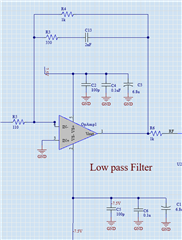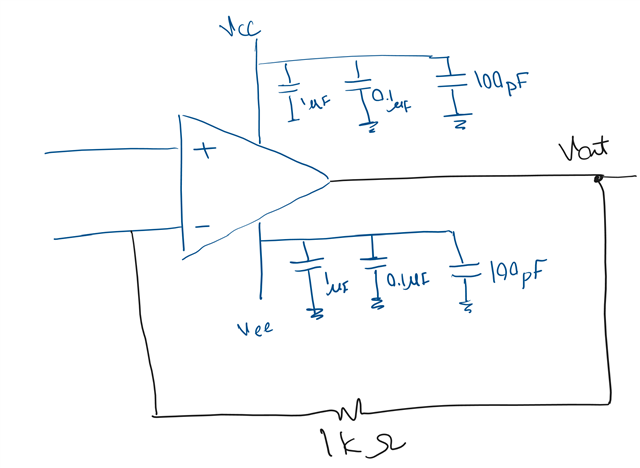Other Parts Discussed in Thread: THS3491
Tool/software:
Dear TI team,
I am currently testing the THS3201 using the inverting amplifier configuration suggested in the datasheet,
...
but I am encountering unexpected behavior.
When powering the amplifier with ±7.5 V (Vs+ = +7.5 V, Vs− = −7.5 V):
The chip heats up significantly within seconds.
The output shows a clean ~300 MHz sine wave, even with zero input signal, and a dc offset is being added to the output signal despite having 0 offset at the input.
But! when switching to a single supply (Vs+ = 15 V, Vs− = 0 V):
The heating issue disappears.
However, the output still oscillates, now around 50 MHz, again regardless of input.
I tested this circuit in different conditions:
*.Tried multiple THS3201 chips to rule out damaged devices.
*. Tested with different feedback and gain resistor values, as suggested in Table 1 of the datasheet (e.g. Rf = 330 Ω, Rg = 110 Ω, etc.).
*.The power supply has been checked for proper voltage, noise, and current handling (by myself and other qualified personnel).
*.Input signal frequency was swept from kHz up to MHz ranges, and even when no signal is applied, the amplifier still produces high-frequency oscillations.
*.I used coaxial cables and proper SMA connections for high-frequency probing, and confirmed the setup using other known working systems.
*.The load at the output is a resistive load (~50 Ω or 100 Ω to ground), no load, or left open in some tests. Incase it was no load at the output and was directly connected to the oscilloscope I could see the input frequency with DC offset however (having 0 and 15V dc supply).
Additional Notes:
This circuit is part of a low-pass filter application, where the input signal may contain frequencies up to 10 GHz, though the output is expected to be under 300 MHz.
Layout is on PCB, and I am aware of the importance of transmission line effects at these frequencies, critical traces are routed as 50 Ω microstrip lines. However, I did the tests to up to 200KHz on breadboard, which should not be an issue.
Despite this, the oscillation appears to originate internally from the op-amp, not due to input signal coupling.
I would appreciate that if you could guide me on the probable reasons why these issues are happening and why I can't get the circuit working with the recommended dc supply values in the datasheet.
Looking forward to your response,
Best regards,
Mahsa



